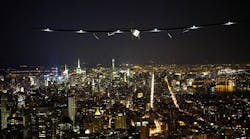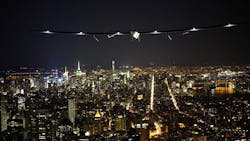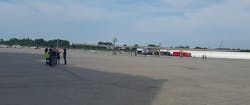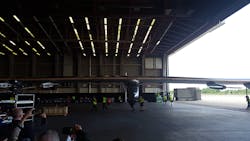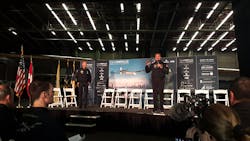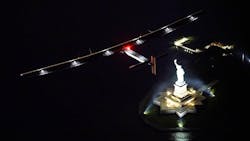On June 7, 2016, the Solar Impulse 2 team, scheduled to land in JFK, delayed its arrival. When flying a prototype plane around the world without any fuel, there are bound to be a few less than ideal weather conditions. But that wasn’t a setback for veteran pilots Bertrand Piccard and Andre Borschberg. They understand that changing the world takes patience. The Solar Impulse 2 has been an idea for over 13 years, and in development for over three. As of June 11, Solar Impulse 2 had set eight world records, visited seven countries, flown over 19,000 miles, and after the weather cleared, landed safely around 4 a.m. at New York’s JFK.
The Solar Impulse 2 team says that it does not carry passengers, but ideas. While much of the philosophy and spirit is to inspire change in the way everyone—businesses and governments included—thinks about green technology, this article will focus only on an overview of the disruptive ideas carried out by this groundbreaking plane. (I’ll talk more about the team’s spirit in a blog you can read coming out later this week.)
According to Swiss pilot and adventurer Piccard, “The idea is to show that you can change the way we do business to be efficient, environmental, and economical.” The team of companies (Solvay, OMEGA, Schindler, ABB, and More) that sat on the stage in Hangar 19 at JFK all have similar beliefs—that an evolution of technology, both environmental and profitable, is imperative to survival. The only way to prove this, as far as the Solar Impulse team was concerned, was through action.
Richard Northcote, chief sustainability officer for Covestro, said his company’s investment into R&D for this project allowed it to generate polyurethane, and discover the right air fill that provides better insulation properties. Through the challenge of trying to build this aircraft, the company found a way to save up to 20% on yearly energy bills compared to standard home insulation. This positive discovery could have a great impact on developing countries with food shortages and limited or no refrigeration.
The urethane that protects the pilots and batteries from extreme conditions without a heating system was able to reduce its volume while providing better insulation and rigidity. The insulation contains 40% smaller pores while still being lightweight. This is only one of the innovations Solar Impulse has on-board. “This product was generated and used for the first time on Solar Impulse,” Northcote says. “Everyone said insulation has reached its [peak] level and it could not get any better. Well, our foam is 10% better than this un-improvable limit … We also have a goal to cut our carbon emissions in half by 2025. One of the ways to do this is to use alternative energy, but this doesn’t do anything to reduce your energy consumption. So our goal for 2030 is to cut our energy consumption in half while continuing to produce the same volumes we are producing today. We have been told that this is not possible, but we have also been told that insulation couldn’t get any better.”
“We produced the garments the pilots wear under the flight suits and about 50% of the composite materials that form the skeleton of the plane,” says Solvay’s communication director David Klucsik. “This technology was not created for Solar Impulse. It existed, and has existed in some cases for a number of years, but the mindset changed. We were able to find ways to apply our technology in ways we thought were impossible ... Solar Impulse is inspiring innovation that is producing better energy efficiencies and light-weighting, and those two themes carry forward into virtually every aspect of our lives.”
Reducing energy and CO2 emissions is not just about saving the planet, but also operating businesses effectively to produce a product that is more effective and cost less because of the efficiency in producing it. This isn’t just a dream. “We have the technology today to cut our CO2 emissions in half,” says Piccard.
With all this innovation and the brilliant minds supporting Solar Impulse 2, it was ready to fly. However, other challenges were just beginning, among them making sure that international governments would allow the team to fly an experimental plane over densely population areas and cross borders to land at international airports. Fortunately, the experience of everyone involved ensured all certifications were received and the global community welcomed the flight. This is an example of what you can accomplish with the right engineers with the desire to challenge what is possible. Even Abu Dhabi, the capital of the United Arab Emirates, said they wanted to host as the start and finish of the adventure, showing a surprising turn toward more sustainable practices.
Key Milestones in the History of Solar Impulse:
1999: Bertrand Piccard’s vision is born
2003: EPFL Feasibility study led by André Borschberg
2004-2009: Start-up financing, design and construction of Solar Impulse 1
2010: First-ever solar-powered day and night flight (André Borschberg)
2011: Special appearance at Paris-le-Bourget International Air Show
2012: First intercontinental solar flight across the Mediterranean to Morocco (Bertrand Piccard)
2013: Across America Mission from San Francisco to New York City
2014: Solar Impulse 2 maiden flight
2015: Departure for the Round-the-World Solar Flight from Abu Dhabi
July 3, 2015: First flight of 5 days and 5 nights without fuel over the Pacific from Nagoya, Japan, to Honolulu, Hawaii and longest solo flight ever achieved (André Borschberg)
April 2016: Round-the-World Solar Flight resumes
Looking for parts? Go to SourceESB.
